|
 |

Part of the American
History & Genealogy Project |
Historic Old New York

Wall Street

Section of City Wall, 1653
Today this name is synonymous with that
of speculation and great financial transactions. It is one of
the famous streets of the world, hut its name has no relation to
the business carried on in it. In 1653, during the reign of
Stuyvesant, when the Dutch were afraid of an attack from the
north, either by the Indians or by the English from the New
England colonies, a wall was built across the island to the
north of the city. It passed through what is now Wall Street,
thence to the Hudson River through the place where Trinity
church now stands.
The wall was a palisade made of posts
twelve feet in length and six inches in diameter; one end was
sharpened and the other set in the ground three feet deep. These
posts were set so close that they touched each other. Split
rails were spiked to the posts to strengthen the palisade.
Within the palisade was a sloping breastwork of earth four feet
high, three feet wide at the top and four feet at the bottom.
There were several semicircular bastions
along the line of the wall, one at East River, projecting into
the river so that the small cannon mounted on it could command
the river both up and down the stream. There was another bastion
near what is now Hanover Street, a third just west of William
Street, another where the sub-treasury building stands, and
still another just east of Broadway.
There was a gate in the wall near the
East River shore, and another at Broadway.
The wall was never used as a means of
defense. When it was torn down the street that was laid out
where the wall had been was not regarded as being one of much
consequence, but its importance was greatly increased when the
new City Hall was erected upon it, opposite Broad Street. The
erection of Trinity church at the head of this street added
greatly to its attractiveness. The first slave market in the
city was at the foot of Wall Street. The first library of the
city had its home in the City Hall. The famous Zenger trial was
held there. It was the City Hall, refurnished and improved, that
was renamed Federal Hall, and it was there that Washington took
the oath of office as President of the United States. It was in
this building that Congress held its sessions as long as New
York remained the capital of the nation.
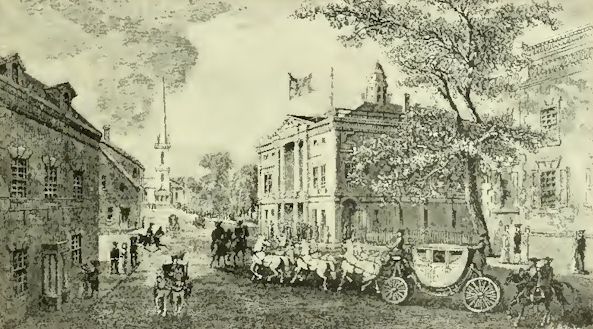
Federal Hall
In 1770 a statue in honor of William
Pitt was erected in Wall Street, near the intersection of
William.
The Bank of New York, the first banking institution established
in the city, was located in Wall Street at the corner of
William. The next five banks established in New York were also
located in Wall Street.
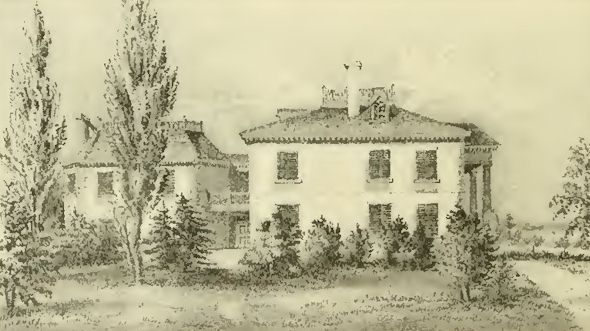
The Jumel Mansion, 161st Street
In 1758 Roger Morris erected a mansion
for his wife, who was the daughter of Frederick Philipse, the
second lord of Philipse Manor. She was the beautiful and
cultured Mary Philipse who tradition says declined the hand of
Washington to marry Morris an aide-de-camp to Braddock. Morris
and his wife lived in this mansion till the beginning of the
Revolution, when, having sided with the royalists, their estate
was confiscated and the family went to England.
This famous old mansion is on 161st
Street near Edgecombe Road. Washington made this house his
headquarters after his retreat from Long Island, and when he was
compelled to abandon the city, General Knyphausen, the Hessian,
occupied it as his headquarters.
It was at this house that the
unfortunate Hale received his final instructions before starting
on his fatal errand, and here that Washington and his cabinet
were guests in 1790.
For some time after the Revolution the
title of the property was in dispute, but in 1810 John Jacob
Astor bought the claims of the Morris heirs. A little later the
house was sold to Stephen Jumel, an adventurous Frenchman who
settled in New York and became one of its leading merchants. He
married a beautiful New England girl and made the Morris mansion
his home. Jerome Bonaparte was a frequent guest of the Jumels,
and Louis Philippe, Lafayette, Talleyrand, and Louis Napoleon
were entertained by them.
Jumel died in 1832, and about a year
later his widow married Aaron Burr. The couple did not live
happily together. Burr squandered his wife's estate and when she
asked for an accounting coolly told her that that was not her
affair, that her husband could manage her estate. The couple
separated within a year from the time of their marriage, and for
thirty-one years after Mrs. Jumel lived in the old mansion,
spending the closing years of her life as a miser and a recluse.
During the time that John Jacob Astor
owned the place it is said that his friend and secretary,
Fitz-Greene Halleck, lived with him and wrote his famous poem
"Marco Bozzaris" in this historic old mansion. The house, which
has now most properly become public property, has not greatly
changed since the time it had for its guests Washington and many
other famous men.
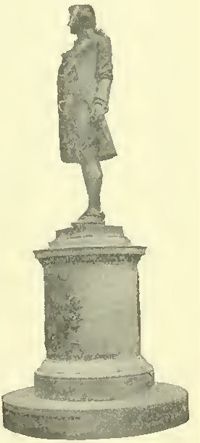
Statue to Nathan Hale
Golden Hill
It was at Golden Hill, in John Street,
near William, that the first blood of the Revolution was shed.
Ever since the passage of the Stamp Act there had been bitter
feeling between the British soldiers and the Sons of Liberty.
The Liberty pole on the Common was made the rallying point of
the patriots, and because of this it was offensive to the
soldiers and was cut down by them. Twice it was replaced by the
Sons of Liberty, and twice cut down again by the soldiers. The
fourth pole was fastened with iron braces, and kept its place
till the night of the 16th of January, 1770, when a party of
soldiers not only cut it down for the fourth time, but cut it in
pieces, and piled the fragments in front of the headquarters of
the Sons of Liberty. This provoked the most intense anger. Two
days later there was a collision on Golden Hill and half a dozen
on each side were wounded; the next day the contest was renewed
and a sailor was killed by the soldiers. These two days'
fighting constitute what is known as the battle of Golden Hill.
This occurred six weeks before the massacre in King Street,
Boston, and five years before the Battle of Lexington, so New
York has reason for the claim made that in her streets was shed
the first blood in the cause of freedom.
The Bowery
Bowery, spelled bouwerie, is a Dutch
word for farm. The road that led through the various farms on
lower Manhattan Island was known as Bouwerie Lane and in time
became the street we now call the Bowery. Along this road grew
up a little hamlet, known as the Bowery. There was at this place
a famous tavern which was a favorite resort. It was here, in
1690, that the Commissioners from the New England colonies met
with those representing New York to consider plans for the
invasion of Canada.
For many years the Bowery was the only
road leading out from the little town clustered about Fort
Amsterdam.
The largest of the bouweries belonged to
Governor Stuyvesant; and it was on the Bowery road that he had
his country home. It was along this road that the post-rider
made his way in carrying the first mail from New York to Boston.
During the Revolution a large part of the British army in New
York was encamped along the Bowery, and the drinking places and
resorts for low grade entertainments that were established there
at that time drove the more fashionable people and the better
class of business to other parts of the city, and did much to
determine the future character of the street.

City Hall
City Hall, Park Row and City Hall Park, 1911
The new City Hall on the corner of Wall
and Nassau Streets, completed in 1700, was a very fine building
for the time. It contained the only prison in the city till
1760, so it must have been here that Zenger was confined during
the imprisonment preceding his trial for libel. It was here that
the Stamp Act congress assembled here that the chief men of the
town met and resolved that they would not pay the tax on tea;
here that the Sons of Liberty came and confiscated the arms and
ammunition stored in one of the rooms, after they had heard the
news from Concord and Lexington. It was from the balcony of the
City Hall that the Declaration of Independence was read, by
order of Congress. It was on the site of this famous City Hall
that the United States Sub-Treasury building was erected.
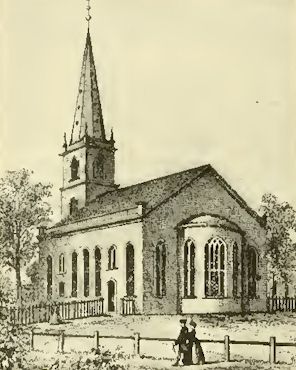
Trinity Church
A Royal grant of land was given to
Trinity in 1697, and the first church erected upon it was
occupied in 1698. This church was destroyed by the great fire of
1776, and was rebuilt in 1778. The present edifice was erected
in 1846. In 1703 the church came into the possession of what was
known as the "King's Farm" which has since been a source of
princely revenue to Trinity. Many churches and parishes owe
their existence to the funds derived from this source. King's
College, now Columbia University, owes its organization to the
same means. All the income from the great estate, which in the
early days was the Annetje Jans farm, is used for the support of
Trinity, and several other churches in the city; in aiding weak
churches in other places; in maintaining hospitals; in providing
scholarships at Trinity College in Hartford, Conn., and for many
other beneficent purposes.
William Vesey, in whose honor Vesey
Street was named, was the first rector of Trinity and served in
that capacity for nearly fifty-years. It is quite remarkable
that in the more than two hundred years of its existence Trinity
has had only nine rectors.
In Trinity Churchyard are the remains of
many noted men. Here lie William Bradford, editor of the first
newspaper in New York; Sir Henry Moore, Sir Danvers Osborne, and
James DeLancey. colonial governors; Robert Livingston; Michael
Cresap, a noted Indian fighter; Alexander Hamilton and Albert
Gallatin, famous Secretaries of the Treasury; the Earl of
Sterling; John Iamb, and Marius Willett, the founders and
leaders of the Sons of Liberty; Philip Livingston and Robert
Lewis, signers of the Declaration of Independence; Robert
Fulton; General Phil. Kearney; Charlotte Temple; James Lawrence,
and many others but little less noted.
The Battery
When the English came into the
possession of the city they proceeded to strengthen the fort by
the erection of batteries. In course of time both the fort and
the associated batteries fell into disuse, and when they were
finally removed, a considerable portion of the territory was
made into a park which is still known as the Battery. It was
here that Lafayette landed on his visit to this country in 1824.
It was here, in Castle Garden, that a grand reception was given
him. It was here that Clay and Webster were heard; here that
Jackson and other Presidents were received; here that Kossuth
was welcomed, and Jenny Lind sang; here that Mario, Grisi, and
many others were heard. But with the opening of the Academy of
Music in Fourteenth Street in 1854 the day of Castle Garden as
the home of the opera came to an end. The following year it
became a landing place for immigrants and continued to be used
for that purpose till 1890, since which time it has been under
the jurisdiction of the department of public parks and used as
the home of the New York Aquarium.
In former years the Battery Park had
been the strolling place of Generals Howe and Clinton; of
Washington, Arnold, and Andre; of Jefferson, Burr, and Hamilton;
of Jerome Bonaparte, and Louis Philippe; of Irving, Cooper,
Halleck, Drake, Willis, and Morris.
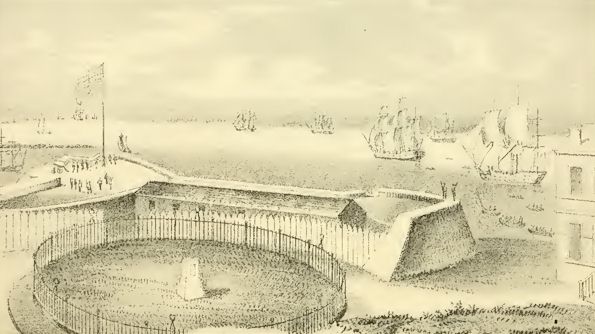
Bowling Green
A small park at the foot of Broadway
that has always been used for public purposes is known as
Bowling Green. When Fort Amsterdam was built the open space to
the north of it was left for a public common, then known as "The
Plaine." It is probable that it was on or near this spot that
Minuit met with the Indians to bargain for Manhattan Island.
This little park in the early days was the village green and the
children's playground. It was here that Governor Kieft
established two annual fairs, one held in October and the other
in November. It was here that the "May-Day" festivals were held.
After a time this plot of ground came to
be known as "The Parade." In 1732 the city fathers leased it to
John Chambers. Peter Bayard, and Peter Jay, who prepared it for
playing the game of bowls, whence the more modern name of the
park. On the 2 1st of August, 1770, a leaden statue of George
the Third was erected in the centre of Bowling Green. Just at
the breaking out of the Revolution the statue was torn down and
sent to Litchfield, Connecticut, where the wife and daughter of
Governor Wolcott made forty-two thousand bullets from it.
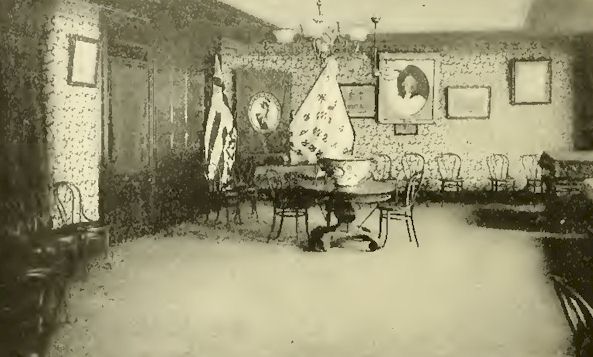
Fraunces' Tavern
This historic building, one of the
oldest in the city, is at the corner of Pearl and Broad Streets.
It was built in 1730 by Stephen DeLancey, a Huguenot nobleman
who fled from France. The firm of DeLancey, Robinson, and
Company occupied the old mansion as a store from 1757 to 1761.
In January, 1762, the property passed into the hands of Samuel
Fraunces, a West Indian, who used it as a tavern. It was for
many years the most popular place in the city, the Delmonico of
its time.
It was the favorite meeting place of
"The Moot," a club composed mainly of lawyers, and which
included in its membership such names as Livingston, Jay,
DeLancey, and Morris. Here also met the "Social Club" having
among its members John Jay, Gouverneur Morris, Robert
Livingston, Morgan Lewis, and Gulian Verplanck. It was at
Fraunces' tavern that the Board of Trade of New York City was
organized. The British held dancing assemblies there during
their occupancy of the city. It was there that Governor Clinton
gave a dinner to Washington and other noted men when the
Americans entered the city after it was evacuated by the
British. It was there that Washington, ten days later, at noon
on the 4th of December, 1783, in the famous "Long Room" bade
farewell to his associates in the army.
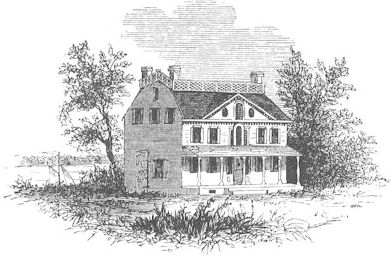
The Beekman House 1860
A house of much historic interest
formerly stood on Fifty-First Street. At the time of the
Revolution it was occupied by James Beekman. Being a loyalist
Beekman fled when Washington entered the city after the Battle
of Long Island. When Sir William Howe was in New York he made
this house his headquarters. It was here that Andre received his
final instructions before going to meet Arnold; here that Nathan
Hale was tried and condemned to be hanged. When Washington was
President, and living in New York, he often stopped at this
house while driving about the city.
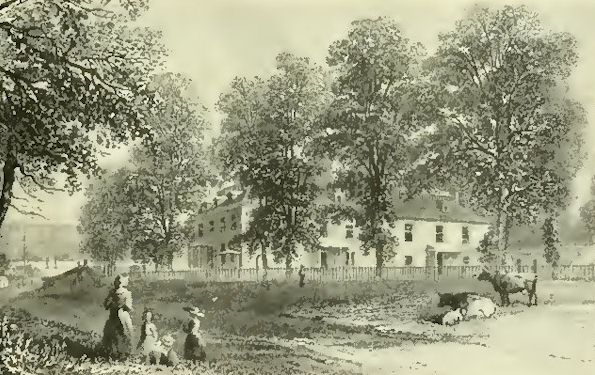
The Philipse Manor House
Although this house was not in the city
of New York its owner and occupant was a part of the city life,
and active in all the affairs that had to do with the city's
welfare. The older part of the house was built in 1682, and the
newer part in 1745. The building as a whole is a curious mixture
of Dutch and English architecture. It was built by Frederick
Philipse, who came to this country a penniless youth of high
birth in the time of Stuyvesant. He engaged in the fur trade and
became the richest man in the colony. His property, together
with that of many other wealthy loyalists, was confiscated after
the Revolution.
The beautiful Mary Philipse, with whom
it is said Washington was deeply in love, lived at the Philipse
Manor House. In 1868 the city of Yonkers bought the Manor House
and converted it into a City Hall.
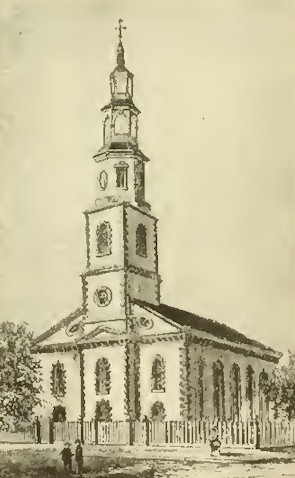
St. George's Chapel
St. George's Chapel stood on the corner
of Cliff and Beekman Streets and was for many reasons a
structure of much interest. It was erected as a chapel by
Trinity Church but later became a separate organization. The
demands of business led to its removal in 1868 and a new
building was erected in Sixteenth Street. The lot on which the
old church stood was purchased in 1748 for $500. It is probably
worth more than a million dollars now. The first subscription
for the church was made by Sir Peter Warren who gave £100 and
asked that a pew be reserved for himself and family in
perpetuity. The installation services were held on the 1st of
July, 1752. St. George's was burned in January, 1814, but was
rebuilt on the same walls. It is said that Washington frequently
attended service here during the early part of the Revolution.
Among the members of St. George's were the Schuylers,
Livingstons, Beekmans, Van Rensselaers, Van Courtlandts, Reades,
Moores and other famous families.
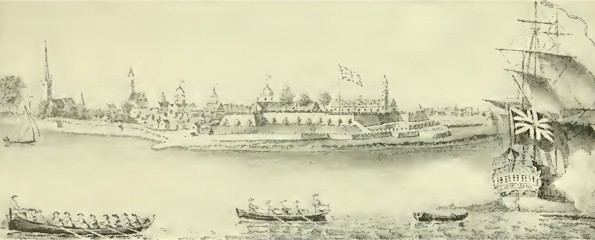
Fort George and City of New York, 1740
Early Schools
Something has already been said of
education under the Dutch and that upon the coming of the
English interest in education languished. It was not until a
considerable time after the close of the Revolution that much
interest was manifested in public education. In 1805 a society
was formed which in 1808 took the name of "Free School Society
of the City of New York." The first building which they erected
was dedicated on the 11th of December. 1805. The dedicatory
address was given by De Witt Clinton, who said the purpose of
the society was not "the founding of a single academy, but the
establishment of schools." By 1825 the society had erected six
school buildings. The first school building was two stories in
height, built of brick, and would accommodate six hundred and
fifty pupils.
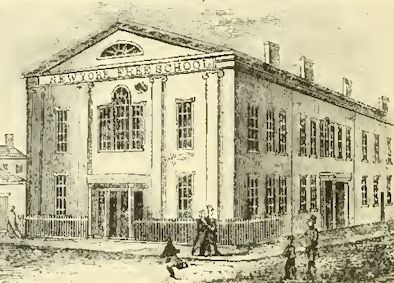
First Free School Building In New York
The Middle Dutch Church
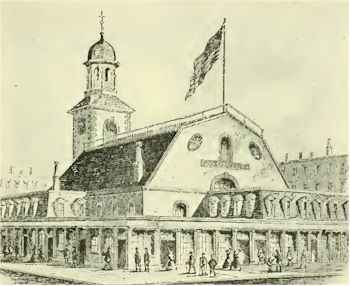
Old Post office, Formerly Middle Dutch Church
This church was situated on Nassau
Street. Between Cedar and Liberty Streets. It was finished in
1731, and was in the fullest sense a Dutch church. The English
language was not used in preaching in it till 1764. The church
would seat about twelve hundred people, and its congregation was
the largest in the city. This church was for a long time
regarded as one of the finest buildings in the city.
During the Revolution it was used as a
military prison. It had to be thoroughly repaired afterwards and
was not reopened for service after the Revolution till 1790. In
1845 it was leased to the United States Government, and used as
a post office for thirty years.

Old Sugar House in Liberty Street
The Old Sugar House in Liberty Street
was used as a prison during the Revolution. More than eight
hundred of the patriots were confined there at one time. They
had almost no bedding and absolutely no fire, during one of the
coldest winters ever known in the city, so cold that for forty
days the Hudson River was frozen over between Cortlandt Street
and the New Jersey shore, as far down as Staten Island. There
were no windows in the building, and the food furnished was poor
and insufficient, "a loaf of bread, a quart of peas, half a pint
of rice, and one and a half pounds of pork for six days." Many
died of want.
AHGP New York

Source: Stories from Early New York
History, by Sherman Williams, New York, Charles Scribner's Sons,
1906
|